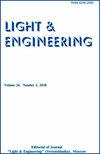人眼视网膜光接收器的光谱灵敏度特性与通用三倍频系统频率的对应关系
IF 0.3
4区 工程技术
Q4 ENGINEERING, ELECTRICAL & ELECTRONIC
引用次数: 1
摘要
这篇文章专门讨论了人类视网膜的光电探测器对UPTS(所谓的普遍周期三倍系统)频率的进化调整。这是研究复杂系统的一个新的科学方向。本文邀请研究视觉感知问题的照明工程师了解UPTS现象。迄今为止,已经积累了大量的实验研究材料,并获得了足够的理论依据,可以提出UPTS及其主要参数Тk, m在几乎所有时间尺度上都表现出来的假设。Тk, m的值用经验的Puetz公式描述得非常精确。在人类视觉中,UPTS以Тk, m的九个周期的形式表现出来,对应于m = - 11, - 8, - 5, - 3, 0, 3, 5, 8和11的情况,其中五个中心周期支配- 5,- 3,0,3和5,对应于杆状细胞,以及B-和r -锥体。关于g锥细胞和ipRGC细胞对指数m = -11、-8、8和11的极端“减弱”值做出反应的问题仍然存在。确定与视网膜光电探测器的最大光谱灵敏度相对应的光波长的拟议计算值对视觉感知、医学、光学领域的专家以及在一些技术应用中的应用是重要的。本文章由计算机程序翻译,如有差异,请以英文原文为准。
On the Correspondence between the Spectral Sensitivity Characteristics of Human Eye Retina Photo-Receivers and the Frequencies of the Universal Period-Tripling System
The article is devoted to the discussion of the evolutionary adjustment of the photodetectors of the human retina to the frequencies of the UPTS (the so-called universal period-tripling system). This is a new scientific direction in the study of complex systems. The article invites lighting engineers who study the issues of visual perception to get acquainted with the phenomenon of UPTS. To date, an experimental research material has been accumulated and sufficient theoretical grounds have been obtained for the formulation of the assumption that the UPTS and its main parameter Тk, m are manifested in almost all time scales. The values of Тk, m are described with great accuracy by means of the empirical Puetz’s formula. In human vision, UPTS manifests itself in the form of nine periods of Тk, m, corresponding to the cases of m = –11, –8, –5, –3, 0, 3, 5, 8, and 11, where the five central ones dominate –5, –3, 0, 3, and 5, corresponding to the rods, as well as the B- and R-cones. Some questions remain about the G-cones and the ipRGC cells that respond to the extreme, “weakened” values of the index m = –11, –8, 8, and 11. The determination of the proposed calculated values of the wavelengths of light corresponding to the maximum spectral sensitivity of retinal photodetectors is important for specialists in the field of visual perception, medicine, optics, as well as for applications in a number of technical applications.
求助全文
通过发布文献求助,成功后即可免费获取论文全文。
去求助
来源期刊

Light & Engineering
ENGINEERING, ELECTRICAL & ELECTRONIC-OPTICS
CiteScore
1.00
自引率
50.00%
发文量
0
审稿时长
1 months
期刊介绍:
Our magazine
develops comprehensive communication within the lighting community, providing opportunities for discussion and free expression of opinions of specialists of different profiles;
contributes to the convergence of science and engineering practice, the search for opportunities for the application of research results in lighting and technological applications of light;
keeps the scientific community up to date with the latest advances in the theory of the light field, providing readers with operational professional information;
initiates international cooperation, promotes and distributes the results of Russian authors in the international professional community;
provides equal opportunities for authors from different regions of Russia and other countries.
The journal publishes articles in the following areas:
visual and non-visual effects of radiation on humans;
light field theory;
photometry and colorimetry;
sources of light;
ballasts;
light devices, their design and production technology;
lighting and irradiation installation;
light signaling;
methods of mathematical modeling of light devices and installations;
problems of energy saving in lighting, installation and operation of lighting installations;
modern production technologies of lighting products for lighting control systems;
innovative design solutions;
innovations in lighting and lighting design;
the study of the effect on plants and animals, problems of using light in medicine;
problems of disinfection of premises, water and smell elimination with the help of technology of UV radiation using;
problems of light in the ocean and space.
 求助内容:
求助内容: 应助结果提醒方式:
应助结果提醒方式:


